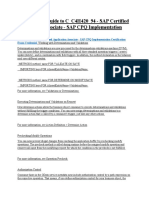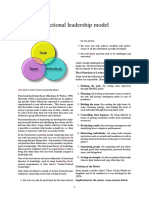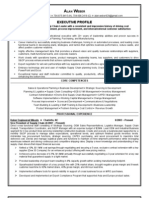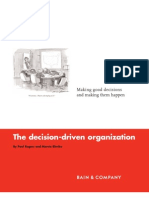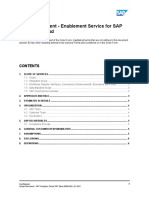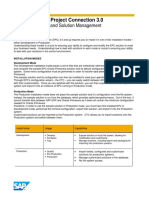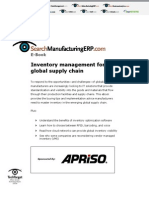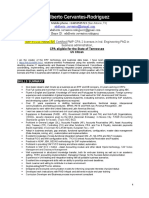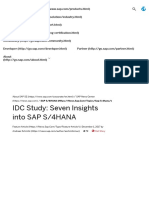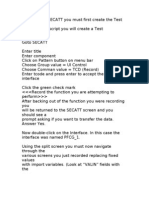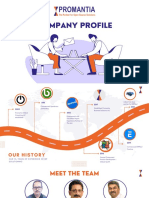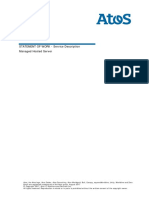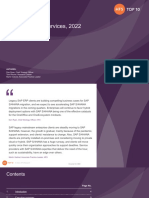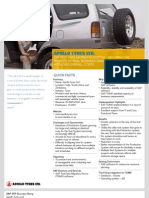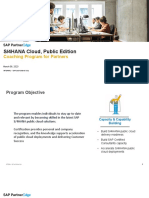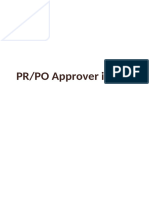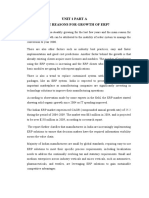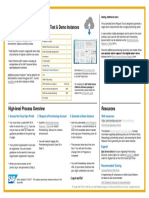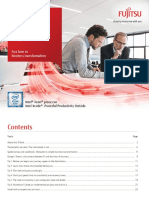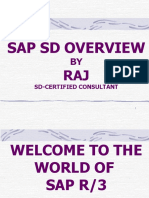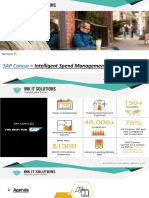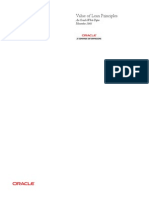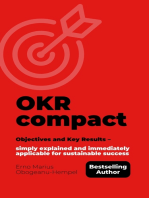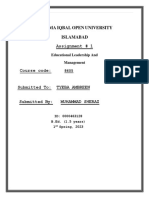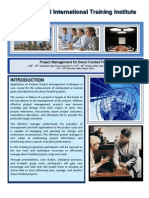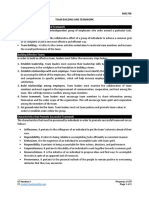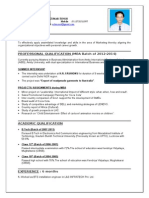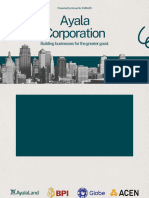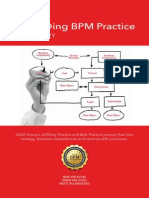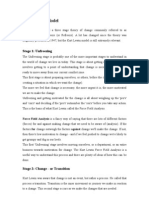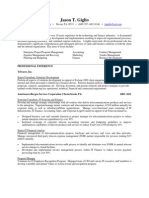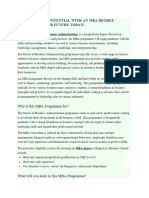CPGR Loreal Whitepaper by Arc
CPGR Loreal Whitepaper by Arc
Uploaded by
Kamal KhuranaCopyright:
Available Formats
CPGR Loreal Whitepaper by Arc
CPGR Loreal Whitepaper by Arc
Uploaded by
Kamal KhuranaOriginal Title
Copyright
Available Formats
Share this document
Did you find this document useful?
Is this content inappropriate?
Copyright:
Available Formats
CPGR Loreal Whitepaper by Arc
CPGR Loreal Whitepaper by Arc
Uploaded by
Kamal KhuranaCopyright:
Available Formats
ARC WHITE PAPER
By ARC Advisory Group
FEBRUARY 2010
Operations Management: The LOral Way
Executive Overview ................................................................... 3
How to Successfully Implement Operations Management ............... 4
Objectives .......................................................................... 4
Approach ............................................................................ 5
Vendor Selection ................................................................. 6
The Project: Pilot and Roll-Out ............................................. 6
A Typical Work Process on a Site Using ISIS ........................... 8
Benefits .............................................................................. 9
Conclusions ..........................................................................10
THOUGHT LEADERS FOR MANUFACTURING & SUPPLY CHAIN
ARC White Paper February 2010
SAP
Reception
Handling
Terminal Terminal
Portable PF Shipping
AC storage
Administrative
Receiving
FlexNet
FlexNet
Physical
Reception
Reception
MP storage
FlexNet
Processing Station
Weighing Station
Weighing
SAP
Quality
FlexNet
Line Station FlexNet
Processing FlexNet
Quality
Qualit
Lab Station
FlexNet
Line Station
Slide 2
detail of supply
Staff Station
to block
Packaging FlexNet
Planning Station
Staff UP
specific HU
FlexNet
FlexNet
& SAP
Planning
SAP
Functional Footprint of the Integrated ISIS
Operations Management Solution
Enterprise/Business
Operations
Inbound
Supply Chain
& Logistics
Product/Plant
Design
Customer
Relationship
Operations
Operations
Management
Management
Systems
Outbound
Supply Chain
& Logistics
Production
Plant/
Equipment &
Manufacturing
Automation
Automation
Engineering
Systems
Collaborative Production Systems for Highly Flexible Manufacturing
2 Copyright ARC Advisory Group ARCweb.com
ARC White Paper February 2010
Executive Overview
LOral, the world leader in cosmetics, is well underway in implementing
an integrated operations management solution across all its factories
worldwide. LOral feels this positions the company as a leading global IT
user, both in terms of technology and user-friendliness. To reap benefits
early, while reducing risk and cost, LOral has implemented both ERP
(SAP) and OM (Aprisos FlexNet) in an integrated manner, site by site, using a common core model.
This model allows LOral to capture best prac-
Terminology
The somewhat dated term, MES
(manufacturing execution system), refers
to a limited subset of functionalities
defined within the ISA95 standard.
At LOral, manufacturing and industrial
logistics operations are modeled in and
automated by a more comprehensive
operations management solution, with the
tices in supply chain management (including
operational logistics), production management,
and quality management and drive operational
excellence uniformly through the organization
by implementing both the applications and the
practices on each site worldwide. Best practices
are owned by business owners who provide a
business diagnosis at sites, helping each define
business operations modeled in and
and implement the required process changes.
automated by the ERP. At LOral, both
Management and personnel at each site take
are part of the same Operations
organizational unit.
ownership for the implementation of their new
processes. This rigorous change management
program, sponsored at a high level by LOrals
VP for Operations, has been crucial to the success and acceptance of the solution.
Cross-functional teams composed of both operations and IS
personnel perform each implementation. IS is an important component to
the success by bringing its competence in system design, implementation,
management, and support to bear on the solution.
As a result, the sites that use the system can rigorously apply the production procedures that optimize product quality and traceability, while
virtually guaranteeing personnel and client security. Traceability and
supply chain information are available in real time throughout the organization, providing additional agility.
Aprisos FlexNet operations management solution provides a flexible platform that lends itself to the core model approach, while providing the outof-the-box, real-time warehouse, logistics, production, and quality management functionality that LOral requires.
Copyright ARC Advisory Group ARCweb.com 3
ARC White Paper February 2010
How to Successfully Implement
Operations Management
Virtually everyone has heard of LOral or used their products. Less well
known, is the philosophy that makes the company so successful and also
helps make their integrated operations management implementation such a
great success. LOral believes that everyone aspires to beauty, so they define their mission as to help men and women around the world realize that
aspiration, while fully expressing their individual personalities. LOral
consistently applies these principles, not only to their customers but also
their employees, society, and the environment. If you sell well-being, you
need to be part of the well-being of the planet, said Jacques Playe, LOral
CIO for Operations. All operational objectives naturally derive from this
philosophy:
LOrals Values
LOral applies their principles,
not only to their customers
ronment
Guaranteeing perfect product quality
Being innovative in processes and packaging
Guaranteeing an excellent level of service and shorter
but also to their employees,
society, and the environment.
If you sell well-being, you
need to be part of the wellbeing of the planet, said
Jacques Playe, LOral CIO for
Operations.
Ensuring the safety of people and protection of the envi-
time-to-market
Minimizing production and logistical costs and invest-
ments
Objectives
Rather than just defining requirements of an operation management system, LOral used a holistic perspective to define their specific requirements
for operations. These included the changes and improvements needed to
be made and how an integrated ERP-operations management solution
could be used to drive excellence through a global company in a sustainable homogenous manner. Specific requirements defined included:
Provide an IT infrastructure including an integrated solution built upon
a platform that guarantees the worldwide consistency of the operations
model
Provide real-time visibility and traceability throughout operations to
manage manufacturing,
4 Copyright ARC Advisory Group ARCweb.com
ARC White Paper February 2010
First Optimize the Process
LOral first optimized the
operations processes, and
then determined how these
could be supported by an
integrated solution.
Too often, inefficient processes
are automated.
Ensure flawless production and logistics operations to
guarantee quality and compliance with the ISO 14001 certification and regulations
LOral called their solution, ISIS, which is both the name
of an Egyptian goddess, and the acronym for Integrated
Solution for Industrial Systems. A logo was developed to
serve as a symbol for integrity and completeness and
represent the solutions capacity to collect dispersed infor-
mation into a coherent system. Values associated with ISIS are: Innovation,
Simplicity, Integration, and Support.
Approach
For each major business process, a process business owner (BO), part of
the LOral operations management team, defines the requirements for the
process. Regional business owners (Zone BOs) support the BO. In an iterative process, the BO or zone BO conducts a business diagnosis on a pilot
site, and, working together with site personnel and management, makes
lists of action item defining the improvements
needed.
Where multiple processes are in-
volved, discussions are sometimes necessary to
determine the overall process corresponding to
all BOs requirements. The site management
takes ownership to implement the changes.
Stphane de Peyrelongue, ISIS implementation program manager, and M.
Playe, jointly insist that the project was largely one of change, referring to
changes in both the processes and in the habits of the employees.
Additionally, the global interaction and sharing among European and
North American project team members has allowed for stronger implementations. Weekly status review meetings offer a venue for discussion on
lessons learned, states Morris Lenczicki, North America Project Manager.
By having this robust interface, it is possible to better focus on the change
management aspects of the project implementation.
Significantly, the specifications for the operations management solution
were derived from the specific requirements of the process design.
During implementations, site management and local key users (LKUs) support the BOs and Zone BOs. This chain facilitates change management,
continuous improvement, and information exchange: the sites are trained in
Copyright ARC Advisory Group ARCweb.com 5
ARC White Paper February 2010
corporate practices; best practices identified by sites are incorporated into
the corporate standard; and the LKUs observations and concerns are quickly addressed.
Vendor Selection
LOral had previously selected SAP for corporate business processes, including supply and demand planning, human resources (HR), and finance.
For operations management, LOral wanted a system that would be easy
for operators to use, while effectively supporting the corporate functions of
the ERP. Following a formal vendor selection process, a well-known MES
provider was chosen, mainly for its production management functionality.
To maximize benefits, LOrals strategy was to implement the integrated
ERP-OM solution, site by site.
LOral had initially assumed that the warehouse management (WM) function would reside in the ERP. However, the central servers could not
ensure 24x7 availability and LOrals dynamic supply chain requires realtime visibility and flawless material movement that requires continuous,
nonstop communications between the warehouse management systems
and the rest of the operations management.
A Dynamic, Global Supply Chain
For LOrals dynamic global supply
chain, warehouse management
needs to be close to real-time and
at least as available as the
production management system.
To eliminate errors and ensure that the supply chain
would not get locked up by contradictory instructions,
it was concluded that -- rather than residing in the corporate
ERP
business
system
--
the
warehouse
management function should, in conjunction with the
operations management system, reside at the local sites
and run in a real-time platform with 24x7 availability.
Upon evaluation, it was determined that the operations management supplier originally selected could only provide this functionality with custom
developments and, thus, the vendor selection process was reactivated. This
time, Apriso was chosen based on its capability to deliver a wide array of
functionalities out of the box, based on a real-time platform that would allow the desired central development and roll out of configured best
practices. Today, LOral uses Apriso FlexNet to manage on-site production, quality, traceability, material movement, and warehouse operations.
The Project: Pilot and Roll-Out
For operations management, one server is used for development and a
second for production. This guarantees the integrity of the source. The
same principle was used for the global ERP development and roll out.
6 Copyright ARC Advisory Group ARCweb.com
ARC White Paper February 2010
On the pilot site, following the business process analysis and optimization,
the process was divided into tasks and the system configuration specified.
The majority of the pilot was developed on site by a cross-functional team
composed of operations and IS personnel and led by the program manager
from IT. According to LOral, having both IS and operations in the same
location allow issues and questions to be sorted out in the shortest time.
The company perceived that this mode of operation accelerated the pilot
development, which took only nine months (including the vendor change).
On average, the project consumed 70 resources, of which 30 were dedicated
to FlexNet. This included personnel from operations, application development, documentation, and training. Every two weeks, both the application
itself and the implications for the process were reviewed in project meetings. LOral managed progress in a classic fashion based on deliverables
by bi-weekly milestone. Project quality control was done by peer review
for each deliverable, followed by a second validation by the BO or Zone BO.
LOral used a beta release for the site to test and become familiar with the
new processes, followed by a production release. BOs and Zone BOs conducted a second audit three months before, and a final audit, just after the
release. Analogous to ERP development and roll out, the resulting FlexNet
application became the core application, applicable to a large extent to
other sites.
Developing on Site
Having both IT and operations in
the same location allows issues
and questions to be sorted out in
LOral used a similar process during the site roll out
phase. Process analysis and improvement begins three
months ahead of the application configuration. This is
necessary, since every site is slightly different and each
the pilot development time.
needs to take ownership of and allow sufficient time to
implement process changes. Site-specific configurations
Developing on Schedule
are based on the core application.
the shortest time, accelerating
By reusing the core model to
implement the solution for
take less time, just seven months on average, since they
During the first years of the rollout phase, two teams --
different sites, implementation is
one in Europe and one in North America performed si-
highly efficient.
multaneous implementations at different sites. Currently,
11 sites are live and the program is on schedule to have
60 percent of group production managed using ISIS by mid 2009. According to LOral, once a site goes live, it immediately reveals glitches in the
actual work processes, even if the theoretical process is perfectly designed.
This leads to further process adjustments and improvements. For example,
QC samples on which non-destructive tests have been done need to be in-
Copyright ARC Advisory Group ARCweb.com 7
ARC White Paper February 2010
tegrated into the finished goods inventory. If the system is not configured
to reflect this, the systems information on the amount of finished goods is
inconsistent with the actual amount, leading to discrepancies in accounting
and excess work-in-progress.
Following initial beta implementation, LOral completed the second
through fifth implementations at a relatively rapid pace. Since LOral was
concerned about deviating too far from the core application, user comments
and concerns were collected and evaluated. Today, a process is in place to
govern the selection and implementation of a best practice into the core
model. These versioning modifications are implemented based upon
both resource availability and validation by the BO. This process helps to
improve user acceptance of the solution and its enhancements.
A Typical Work Process on a Site Using ISIS
With ISIS, production planning is done in the SAP-APO module, complemented at some sites by a detailed production scheduler. Based on realtime information and supported by agile processes, production can be rescheduled up to three days before production. The objective is to provide
flexibility, while protecting site operations from excessive disturbances.
When primary materials are received on site, they are identified and labeled; the material composition and history, lot number and the identity of
the provider are entered. Samples are taken and tested to verify that the
primary materials quality meets specification. Once the lot is accepted, the
What the Operators Say
results are attached to a lot identifier and all information is available to operators throughout the
One operator said that she feels secure
production process by scanning the label. The sys-
because she is certain to execute the
procedures correctly.
Another says that operations are
simpler than before and that the
system saves her time. She feels
autonomous and responsible for her
work, and more comfortable.
tem chooses a location in which to store the
material, indicates this to the fork truck driver, and
manages primary material inventory.
In production, when an operator opens a production order, the corresponding recipe is displayed
and guides the operator through the procedure. The
system checks the availability of primary materials for the lot before production starts and then guides the operator through the different
production steps. When the operator scans the materials, the system verifies that it is the right material and complies with the quality specifications.
This guidance increases operator comfort level in being able to execute the
procedures correctly. This is significant when you consider that each site
8 Copyright ARC Advisory Group ARCweb.com
ARC White Paper February 2010
can produce products according to hundreds, or even thousands, of different recipes.
ISIS visually guides the operator through the weighing process to match the
recipe. The actual amount of material consumed is automatically recorded
and the primary material inventory is updated. An identification label is
printed and affixed to the product. In the system, this identifier is linked to
all information on primary materials, their composition, quality, and shelf
lives for the lot.
Before each packaging operation, the system checks the availability of both
equipment and packaging materials and characteristics. The system informs the fork truck driver which materials and products to bring to the
packaging station. Upon arrival at the station, the packaging operator
scans the materials to check the procedure for the order. The system also
prescribes the quality control samples that must be taken to comply with
the ISO standard, while optimizing the number of quality checks. This too
increases operator confidence in being able to execute orders correctly. Interviews with packaging line operators confirm that the system is simple to
use, saves time by reducing the need to search for information, and thus
helps contribute to reduced stress in the workplace. The system also managed product shipping, including real-time material movement, order
management, and inventory management functionality.
Benefits
The benefits that LOral reports from ISIS correspond exactly to the companys objectives. Specific benefits mentioned include improved security
for clients and personnel; improved rigor in production and quality proceSolution Benefits
Improved security for clients and personnel
Rigor in production and quality procedures
Real-time, on-line traceability
Comfort and satisfaction for the operators
Products of irreproachable quality
dures to enable real-time, on-line traceability; a more comfortable and satisfying work
environment; and consistently high quality
products for consumers. In short, the system both monitors and guarantees the
proper production process.
According to M. Playe, Apriso FlexNet simplifies many things for LOral. From a global point of view, the diversity
of practices is reduced and practices across the global manufacturing sites
more closely conform to corporate best practices. This corresponds to the
objective of driving global operational excellence. Operations activities at
each site are simplified or reduced in number. An example is automated
Copyright ARC Advisory Group ARCweb.com 9
ARC White Paper February 2010
dispatching of production orders on production lines, as well as automation of many other production, quality, and warehouse management tasks.
Simplification encourages usage of the integrated ERP-OM application, and
has not only direct benefits for production, but also brings synergistic beneIntegration Benefits
Facilitates and stimulates ERP usage
Integrated ERP-OM roll-out brings
benefits earlier, reduces elapsed
time, cost, and risk compared to
sequential implementations
fits through more effective ERP usage enabled by
the OM. Examples include fewer discrepancies of
actual-versus-plan, reduced primary materials consumption, less work-in-progress and reduced
finished
goods
inventories,
reducing
waste
throughout the manufacturing process.
Obviously, the simultaneous ERP-OM implementation has brought benefits
earlier than a two-stage implementation. LOral also mentions that introducing the ERP and the OM solution separately would have increased cost
and risk. In this case, the joint ERP and OM implementation yielded combined benefits that exceeded those that LOral would have realized from
implementing each application as a stand-alone solution.
Conclusions
Successful implementations of change in an organization, such as large
IT deployments, require a change management approach that transfers
ownership for the changes to those who have to apply those changes,
such as site management and personnel. Ownership can only be transferred when the project sponsor fulfills his/her role.
IT has an
important role, as a service provider.
A core model approach is one of the most efficient ways to manage
large-scale operations management implementations. A flexible platform, such as Apriso FlexNet, allows processes and best practices to be
captured and globally distributed.
An OM solution combined with ERP can deliver greater combined benefits than separate, sequenced implementations.
To manage an integrated supply chain on a global scale that operates in
near-real-time, warehouse management and logistic functions of OM
need to be real-time applications and available 24x7, or at least according to the same specification as the manufacturing-related functions of
the OM solution. Each of these OM applications needs to seamlessly
communicate with other enterprise applications, such as ERP and PLM.
10 Copyright ARC Advisory Group ARCweb.com
ARC White Paper February 2010
Analyst: Valentijn de Leeuw
Editors:
Greg Gorbach, Paul Miller
Acronym Reference
For a complete list of industry acronyms, refer to our web page at
www.arcweb.com/Research/IndustryTerms/.
BO
Business Owner
LKU
Local Key User
CIO
Chief Information Officer
MES
Manufacturing Execution System
ERP
Enterprise Resource Planning
OBO Operational Business Owner
ISO
International Standards
OM
Operations Management
Organization
QC
Quality Control
Information Technology
WM
Warehouse Management
IT
Founded in 1986, ARC Advisory Group has grown to become the Thought
Leader in Manufacturing and Supply Chain solutions. For even your most
complex business issues, our analysts have the expert industry knowledge and
firsthand experience to help you find the best answer. We focus on simple,
yet critical goals: improving your return on assets, operational performance,
total cost of ownership, project time-to-benefit, and shareholder value.
All information in this report is proprietary to and copyrighted by ARC. No part
of it may be reproduced without prior permission from ARC. This research has
been sponsored in part by Apriso. However, the opinions expressed by ARC in
this paper are based on ARC's independent analysis.
You can take advantage of ARC's extensive ongoing research plus experience
of our staff members through our Advisory Services. ARCs Advisory Services
are specifically designed for executives responsible for developing strategies
and directions for their organizations. For membership information, please
call, fax, or write to:
ARC Advisory Group, Three Allied Drive, Dedham, MA 02026 USA
Tel: 781-471-1000, Fax: 781-471-1100, Email: info@arcweb.com
Visit our web page at arcweb.com
Copyright ARC Advisory Group ARCweb.com 11
3 ALLIED DRIVE
DEDHAM, MA 02026
USA
781-471-1000
USA | GERMANY | JAPAN | INDIA | CHINA | BRAZIL | A RGENTINA
You might also like
- SAP Data IntelligenceDocument4 pagesSAP Data Intelligenceajitpatil9535No ratings yet
- The Ultimate Guide To C - C4H420 - 94 - SAP Certified Application Associate - SAP CPQ ImplementationDocument2 pagesThe Ultimate Guide To C - C4H420 - 94 - SAP Certified Application Associate - SAP CPQ ImplementationStefanNo ratings yet
- Functional Leadership ModelDocument3 pagesFunctional Leadership Modelalberto micheliniNo ratings yet
- Rational Unified Process: Best Practices For Software Development TeamsDocument21 pagesRational Unified Process: Best Practices For Software Development TeamsCristal NgoNo ratings yet
- Vice President Supply Chain in Charlotte North Carolina Resume Alan WeberDocument3 pagesVice President Supply Chain in Charlotte North Carolina Resume Alan Weberalanweber1100% (1)
- Decision Driven OrganizationDocument16 pagesDecision Driven OrganizationatifmusheerNo ratings yet
- SAP MII Help 15.1Document1,074 pagesSAP MII Help 15.1Pradeep KumarNo ratings yet
- openSAP S4h35 Week 2 Unit 01 DIRECRRRT PresentationDocument17 pagesopenSAP S4h35 Week 2 Unit 01 DIRECRRRT PresentationsampathNo ratings yet
- Architecture Point of View InfosheetDocument5 pagesArchitecture Point of View InfosheetSrinivasan NarasimmanNo ratings yet
- Microsoft Official Courseware Title Plan Updated 23 April 2020Document66 pagesMicrosoft Official Courseware Title Plan Updated 23 April 2020Andrei BobocNo ratings yet
- ES SAP SAC Store V4 Scope Doc EN XXDocument7 pagesES SAP SAC Store V4 Scope Doc EN XXsudhir.kanakotiNo ratings yet
- ASC Adapter NWDocument118 pagesASC Adapter NWDurantNo ratings yet
- SAP EPC 3.0 - SolutionManagementDocument4 pagesSAP EPC 3.0 - SolutionManagementUsmanKhalidNo ratings yet
- Implementation of Sap at Indian OilDocument8 pagesImplementation of Sap at Indian OilSINDHUDEARNo ratings yet
- Sapprojectsystem 221214075318 1070386eDocument52 pagesSapprojectsystem 221214075318 1070386esuresh chariNo ratings yet
- ASUG11864 11864 Presentation 1Document37 pagesASUG11864 11864 Presentation 1Real PlayerNo ratings yet
- Apriso SmanufacturingDocument17 pagesApriso SmanufacturingArvin PagarNo ratings yet
- WW Tipsheet-Industry Tips and Tricks From Sap ConcurDocument43 pagesWW Tipsheet-Industry Tips and Tricks From Sap ConcurAntonNo ratings yet
- Cervantes Adalberto 2020 SAPFICO Projectsver6Document15 pagesCervantes Adalberto 2020 SAPFICO Projectsver6Jacob juarezNo ratings yet
- Aravind Chinthala: SAP Data Migration ConsultantDocument1 pageAravind Chinthala: SAP Data Migration ConsultantAravind ChNo ratings yet
- IDC Study On SAP S4HANA InsightsDocument9 pagesIDC Study On SAP S4HANA InsightsRoger WaymenNo ratings yet
- New Extractors For Transactional Data - V1Document15 pagesNew Extractors For Transactional Data - V1geneNo ratings yet
- Timeline SAP Gov of Brunei v04Document16 pagesTimeline SAP Gov of Brunei v04Dicky AfrizalNo ratings yet
- Alert Configuration For SAP PI PO 1702036307Document10 pagesAlert Configuration For SAP PI PO 1702036307Luis MariñoNo ratings yet
- ERP - New - Lab Manual - 2Document26 pagesERP - New - Lab Manual - 2rohanNo ratings yet
- SAP HistoryDocument9 pagesSAP Historyafzal47No ratings yet
- 2019 ISV Analytics Solution Guide April 17 2019Document17 pages2019 ISV Analytics Solution Guide April 17 2019vramalhoNo ratings yet
- What Is eCATTDocument122 pagesWhat Is eCATTjoseph davidNo ratings yet
- Promantia Profile 2023Document21 pagesPromantia Profile 2023Prashant A UNo ratings yet
- GTA-Service Managed Hosted ServerDocument24 pagesGTA-Service Managed Hosted ServerShubham ShawNo ratings yet
- SAP Technology Professionals GuideDocument8 pagesSAP Technology Professionals GuideMoiz AliNo ratings yet
- Intro To ERPshortDocument41 pagesIntro To ERPshortYudha PP100% (1)
- S4irt en Col02 Co A4Document19 pagesS4irt en Col02 Co A4aruprc1910No ratings yet
- Hfs Top 10 - Sap S - 4hana Services, 2022Document30 pagesHfs Top 10 - Sap S - 4hana Services, 2022Arun KumarNo ratings yet
- Apollo TyresDocument4 pagesApollo TyresSomnath Mangaraj100% (1)
- Nimesh DesaiDocument5 pagesNimesh DesaiSourabh SharmaNo ratings yet
- Virtual Orientation 20230308Document36 pagesVirtual Orientation 20230308Tarun JainNo ratings yet
- Sap PR-PO ApproverDocument47 pagesSap PR-PO ApproversapallianceaNo ratings yet
- SAP Hana B2Document2 pagesSAP Hana B2manishcsap3704No ratings yet
- Unit 1 Part ADocument42 pagesUnit 1 Part AShanthiNo ratings yet
- RPA Manufacturing Use CasesDocument12 pagesRPA Manufacturing Use CasesbbbbagNo ratings yet
- SuccessFactors Test and Demo - NP2 3-2-17 PDFDocument1 pageSuccessFactors Test and Demo - NP2 3-2-17 PDFAnk1313No ratings yet
- Ebook Primeflex For Sap HanaDocument23 pagesEbook Primeflex For Sap HanaEnrique Espindola BarajasNo ratings yet
- Company Setup: 1. How To Create A New CompanyDocument93 pagesCompany Setup: 1. How To Create A New Companywahahaha jhonshonsNo ratings yet
- Sap Solution Manager Expert - Resume - CV - Wenceslao LacazeDocument5 pagesSap Solution Manager Expert - Resume - CV - Wenceslao Lacazehttp://wlacaze.googlepages.com/home100% (7)
- TMS Platform Adoption - 2021 MayDocument12 pagesTMS Platform Adoption - 2021 Mayraghunandhan.scrumNo ratings yet
- Hci10 Help Sap enDocument408 pagesHci10 Help Sap enSourav SutradharNo ratings yet
- Unit 1: SAP S/4HANA Production Planning OverviewDocument2 pagesUnit 1: SAP S/4HANA Production Planning OverviewSaphana CfinNo ratings yet
- Rapid Decision For JD Edwards 20081Document8 pagesRapid Decision For JD Edwards 20081SursarovarNo ratings yet
- Apriso QualityManagementDocument41 pagesApriso QualityManagementrgil252No ratings yet
- 166 ERP606 BB ConfigGuide EN CNDocument8 pages166 ERP606 BB ConfigGuide EN CNNoSpamNo ratings yet
- Chandan ReddyDocument5 pagesChandan ReddyAfsar AbdulNo ratings yet
- THARINDU THARAKA BANDURATHNA-TemplateDocument4 pagesTHARINDU THARAKA BANDURATHNA-TemplatekanimozhiNo ratings yet
- Rework in Manufacturing - SAP BlogsDocument12 pagesRework in Manufacturing - SAP Blogsadama aubin alexis TOURENo ratings yet
- Assignment 2Document8 pagesAssignment 2paul.oyakhilomeNo ratings yet
- Ariba Network Order Guide PDFDocument37 pagesAriba Network Order Guide PDFparthascNo ratings yet
- SAP Retail Overview Mickael QUESNOT ©Document123 pagesSAP Retail Overview Mickael QUESNOT ©Anil KumarNo ratings yet
- Sap DemoDocument44 pagesSap Demokishore1101285No ratings yet
- Our Sap Practice Value Proposition: PlanningDocument2 pagesOur Sap Practice Value Proposition: PlanningKaushal100% (1)
- SAP Concur - DeckDocument10 pagesSAP Concur - DeckMukesh BawalNo ratings yet
- Top 30 MicroStrategy Interview Questions and Answers For 2023Document12 pagesTop 30 MicroStrategy Interview Questions and Answers For 2023Jacky GurnaniNo ratings yet
- Value of Lean Principles: An Oracle White Paper November 2003Document17 pagesValue of Lean Principles: An Oracle White Paper November 2003Pawan RaiNo ratings yet
- OKR compact: Objectives and Key Results - simply explained and immediately applicable for sustainable successFrom EverandOKR compact: Objectives and Key Results - simply explained and immediately applicable for sustainable successNo ratings yet
- 2 Thematic Analysis Template 1Document24 pages2 Thematic Analysis Template 1api-664989901No ratings yet
- Women in Water UtilitiesDocument92 pagesWomen in Water UtilitiessofiabloemNo ratings yet
- Rajkumar SKILLSDocument21 pagesRajkumar SKILLSraj kumarNo ratings yet
- Leadership Preferences in Japan 2007Document23 pagesLeadership Preferences in Japan 2007kashif salman100% (1)
- Education Sciences: An Application of Hofstede's Cultural Dimension Among Female Educational LeadersDocument15 pagesEducation Sciences: An Application of Hofstede's Cultural Dimension Among Female Educational Leaderssyeda salmaNo ratings yet
- Performance Appraisal in Public ServiceDocument12 pagesPerformance Appraisal in Public Servicejoelochapa1977No ratings yet
- Case Analysis of P&GDocument16 pagesCase Analysis of P>ewelde Mezgobo83% (12)
- Sundaram Clayton'sDocument5 pagesSundaram Clayton'sRaymart GonzagaNo ratings yet
- AssignmentNO 1 8605 Spring 2023Document24 pagesAssignmentNO 1 8605 Spring 2023AleenaNo ratings yet
- Growth Mindset Why It's Needed For Successful LeadershipDocument14 pagesGrowth Mindset Why It's Needed For Successful Leadershipsajalasati98No ratings yet
- Effect of Leadership Style On The Performance of Small and Medium Scale Enterprises Smes in Federal Capital Territory FCT Abuja 3Document13 pagesEffect of Leadership Style On The Performance of Small and Medium Scale Enterprises Smes in Federal Capital Territory FCT Abuja 3Saheed AbdulazeezNo ratings yet
- Competency Assessment Tier1-Completed-2021Document20 pagesCompetency Assessment Tier1-Completed-2021api-439027462No ratings yet
- Andrew Arche Resume For HavenwyckDocument1 pageAndrew Arche Resume For Havenwyckapi-532284965No ratings yet
- Course Outline - PROJECT Management For Donor Funded Project - Cape Town - 2013 - 2014Document5 pagesCourse Outline - PROJECT Management For Donor Funded Project - Cape Town - 2013 - 2014profession0% (1)
- GE6757 Unit-1Document92 pagesGE6757 Unit-1Dhamotharan SNo ratings yet
- PCED110 The Teacher and The Community, School Culture and Organizational LeadershipDocument6 pagesPCED110 The Teacher and The Community, School Culture and Organizational LeadershipPerly BarongNo ratings yet
- Overview of Team Building and Teamwork: Student - Feedback@sti - EduDocument3 pagesOverview of Team Building and Teamwork: Student - Feedback@sti - EduCristopher Rico DelgadoNo ratings yet
- Ufone ReportDocument15 pagesUfone ReportMian Sarmad AshrafNo ratings yet
- Achin Kumar SinghDocument2 pagesAchin Kumar SinghEr Achin SinghNo ratings yet
- GSTM Project Management Leaflet - zp169276Document6 pagesGSTM Project Management Leaflet - zp169276percyvall2No ratings yet
- Case Analysis On Ayala CorporationDocument45 pagesCase Analysis On Ayala CorporationeagonzalesdetorresNo ratings yet
- LEGO LEADing BPM Practice Case StoryDocument39 pagesLEGO LEADing BPM Practice Case StoryAlexandra MocanuNo ratings yet
- Kurt Lewin ModelDocument4 pagesKurt Lewin Modelverinderpreet100% (1)
- Director Sourcing Finance Vendor Management in Philadelphia PA Resume Jason GiglioDocument2 pagesDirector Sourcing Finance Vendor Management in Philadelphia PA Resume Jason GiglioJasonGiglioNo ratings yet
- Report On Organizational Behavior of NIB BankDocument21 pagesReport On Organizational Behavior of NIB BankMuhammad IrfanNo ratings yet
- Unit 20 LO4Document75 pagesUnit 20 LO4Ryk RamosNo ratings yet
- MBA Read MoreDocument8 pagesMBA Read MoresyedtregenesysNo ratings yet

